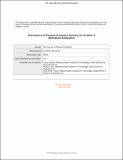Descriptors of Oxygen-Evolution Activity for Oxides: A Statistical Evaluation
Author(s)
Hong, Wesley Terrence; Welsch, Roy E; Shao-Horn, Yang
DownloadHong_JPCC_revision_submitted.pdf (936.6Kb)
PUBLISHER_POLICY
Publisher Policy
Article is made available in accordance with the publisher's policy and may be subject to US copyright law. Please refer to the publisher's site for terms of use.
Terms of use
Metadata
Show full item recordAbstract
Catalysts for oxygen electrochemical processes are critical for the commercial viability of renewable energy storage and conversion devices such as fuel cells, artificial photosynthesis, and metal-air batteries. Transition metal oxides are an excellent system for developing scalable, non-noble-metal-based catalysts, especially for the oxygen evolution reaction (OER). Central to the rational design of novel catalysts is the development of quantitative structure–activity relationships, which correlate the desired catalytic behavior to structural and/or elemental descriptors of materials. The ultimate goal is to use these relationships to guide materials design. In this study, 101 intrinsic OER activities of 51 perovskites were compiled from five studies in literature and additional measurements made for this work. We explored the behavior and performance of 14 descriptors of the metal–oxygen bond strength using a number of statistical approaches, including factor analysis and linear regression models. We found that these descriptors can be classified into five descriptor families and identify electron occupancy and metal–oxygen covalency as the dominant influences on the OER activity. However, multiple descriptors still need to be considered in order to develop strong predictive relationships, largely outperforming the use of only one or two descriptors (as conventionally done in the field). We confirmed that the number of d electrons, charge-transfer energy (covalency), and optimality of eg occupancy play the important roles, but found that structural factors such as M–O–M bond angle and tolerance factor are relevant as well. With these tools, we demonstrate how statistical learning can be used to draw novel physical insights and combined with data mining to rapidly screen OER electrocatalysts across a wide chemical space.
Date issued
2015-12Department
Massachusetts Institute of Technology. Department of Materials Science and Engineering; Massachusetts Institute of Technology. Department of Mechanical Engineering; Sloan School of ManagementJournal
The Journal of Physical Chemistry C
Publisher
American Chemical Society (ACS)
Citation
Hong, Wesley T., Roy E. Welsch, and Yang Shao-Horn. “Descriptors of Oxygen-Evolution Activity for Oxides: A Statistical Evaluation.” The Journal of Physical Chemistry C 120, no. 1 (January 14, 2016): 78–86.
Version: Author's final manuscript
ISSN
1932-7447
1932-7455